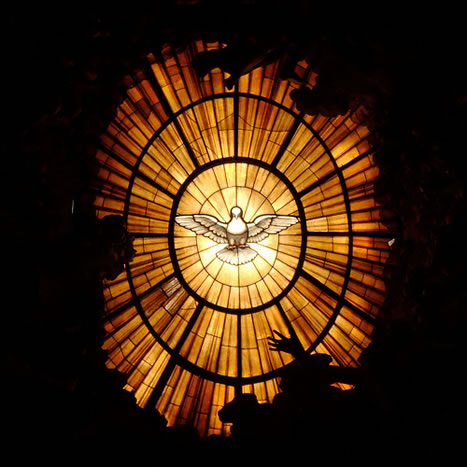
Holy Spirit Window, St. Peter’s Basilica, Vatican City
FROM that letter in Part I:
I go out of my way to attend a church that is very traditional—where people dress properly, remain quiet in front of the Tabernacle, where we are catechized according to Tradition from the pulpit, etc.
I stay far away from charismatic churches. I just don’t see that as Catholicism. There is often a movie screen on the altar with parts of the Mass listed on it (“Liturgy,” etc.). Women are on the altar. Everyone is dressed very casually (jeans, sneakers, shorts, etc.) Everyone raises their hands, shouts, claps—no quiet. There is no kneeling or other reverent gestures. It seems to me that a lot of this was learned from the Pentecostal denomination. No one thinks the “details” of Tradition matter. I feel no peace there. What happened to Tradition? To silence (such as no clapping!) out of respect for the Tabernacle??? To modest dress?
I was seven years old when my parents attended a Charismatic prayer meeting in our parish. There, they had an encounter with Jesus that profoundly changed them. Our parish priest was a good shepherd of the movement who himself experienced the “baptism in the Spirit.” He permitted the prayer group to grow in its charisms, thereby bringing many more conversions and graces to the Catholic community. The group was ecumenical, and yet, faithful to the teachings of the Catholic Church. My dad described it as a “truly beautiful experience.”
In hindsight, it was a model of sorts of what the popes, from the very beginning of the Renewal, wished to see: an integration of the movement with the whole Church, in fidelity to the Magisterium.
UNITY!
Recall the words of Paul VI:
This authentic desire to situate yourselves in the Church is the authentic sign of the action of the Holy Spirit … —POPE PAUL VI, —International Conference on the Catholic Charismatic Renewal, May 19, 1975, Rome, Italy, www.ewtn.com
While head of the Congregation for the Doctrine of the Faith, Cardinal Ratzinger (Pope Benedict XVI), in a foreword to Léon Joseph Cardinal Suenen’s book, urged a mutual embrace…
…for the ecclesial ministry—from parish priests to bishops—not to let the Renewal pass them by but to welcome it fully; and on the other… the members of the Renewal to cherish and maintain their link with the whole Church and with the charisms of her pastors. —Renewal and the Powers of Darkness,p. xi
Blessed Pope John Paul II, echoing his predecessors, embraced the Renewal wholeheartedly as the Holy Spirit’s “providential response” to a “world, often dominated by a secularized culture which encourages and promotes models of life without God.” [1]Speech for the World Congress of Ecclesial Movements and New Communities, www.vatican.va He too strongly urged the new movements to remain in communion with their bishops:
In the confusion that reigns in the world today, it is so easy to err, to give in to illusions. May this element of trusting obedience to the Bishops, the successors of the Apostles, in communion with the Successor of Peter, never be lacking in the Christian formation provided by your movements! —POPE JOHN PAUL II, Speech for the World Congress of Ecclesial Movements and New Communities, www.vatican.va
And so, has the Renewal been faithful to their exhortations?
NEW LIFE, NEW MASS, NEW PROBLEMS…
The answer is by and large yes, according to not only the Holy Father’s, but also bishop’s conferences throughout the world. But not without bumps. Not without the normal tensions that arise with sinful human nature, and all that brings. Let us be realistic: in every authentic movement in the Church, there are always those who go to the extremes; those who are impatient, proud, divisive, overly zealous, ambitious, rebellious, etc. And yet, the Lord uses even these to purify and “make all things work to the good for those who love Him.” [2]cf. Rom 8:28
And thus it is appropriate here to call to mind, with no little sadness, the liberal theology that also emerged after Vatican II from those who used the new impetus of the Council to introduce error, heresy, and liturgical 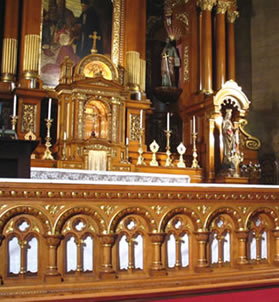 abuses. The criticisms my reader describes above are inappropriately attributed to the Charismatic Renewal as causal. The destruction of the mystical, the so-called “Protestantization” of the Mass; the removal of Sacred Art, the altar rail, high altars and even the Tabernacle from the sanctuary; the gradual loss of Catechesis; the disregard for the Sacraments; the dispensing of kneeling; the introduction of other liturgical inventions and novelties… these came about as a result of an invasion of radical feminism, new age spirituality, rogue nuns and priests, and a general rebellion against the hierarchy of the Church and her teachings. They were not the intention of the Council Fathers (as a whole) or its documents. Rather, they have been the fruit of a general “apostasy” that cannot be attributed to any single movement, per se, and that in fact preceded the Charismatic Renewal:
abuses. The criticisms my reader describes above are inappropriately attributed to the Charismatic Renewal as causal. The destruction of the mystical, the so-called “Protestantization” of the Mass; the removal of Sacred Art, the altar rail, high altars and even the Tabernacle from the sanctuary; the gradual loss of Catechesis; the disregard for the Sacraments; the dispensing of kneeling; the introduction of other liturgical inventions and novelties… these came about as a result of an invasion of radical feminism, new age spirituality, rogue nuns and priests, and a general rebellion against the hierarchy of the Church and her teachings. They were not the intention of the Council Fathers (as a whole) or its documents. Rather, they have been the fruit of a general “apostasy” that cannot be attributed to any single movement, per se, and that in fact preceded the Charismatic Renewal:
Who can fail to see that society is at the present time, more than in any past age, suffering from a terrible and deep-rooted malady which, developing every day and eating into its inmost being, is dragging it to destruction? You understand, Venerable Brethren, what this disease is—apostasy from God… —POPE ST. PIUS X, E Supremi, Encyclical On the Restoration of All Things in Christ, n. 3; October 4th, 1903
 In fact, it was Dr. Ralph Martin, one of the participants in the Duquesne weekend and founders of the modern Charismatic Renewal who warned:
In fact, it was Dr. Ralph Martin, one of the participants in the Duquesne weekend and founders of the modern Charismatic Renewal who warned:
There has never been such a falling away from Christianity as there has been in the past century. We are certainly a “candidate” for the Great Apostasy. —What in the World is Going On? Television documenatary, CTV Edmonton, 1997
If elements of this apostasy showed up in certain members of the Renewal, that was indicative of a ‘deep-rooted maladay’ infecting great portions of the Church, not to mention nearly all of the religious orders.
…there’s no easy way to say it. The Church in the United States has done a poor job of forming the faith and conscience of Catholics for more than 40 years. And now we’re harvesting the results—in the public square, in our families and in the confusion of our personal lives. —Archbishop Charles J. Chaput, O.F.M. Cap., Rendering Unto Caesar: The Catholic Political Vocation, February 23rd, 2009, Toronto, Canada
What is said here of America could easily be said of many other “Catholic” nations. Thus, a generation has been raised where “irreverence” is normal, where the mystical language of 200 centuries of signs and symbols have been often eliminated or ignored (especially in North America), and are no longer even part of the “memory” of new generations. Therefore, many of today’s movements, Charismatic or otherwise, share to one degree or another in the common language of the parish that has, in most of the Western Church, radically changed since Vatican II.
THE RENEWAL IN THE PARISH
What so-called Charismatic Masses did introduce, generally speaking, was a new vibrancy to many parishes, or at least an attempt to do so. 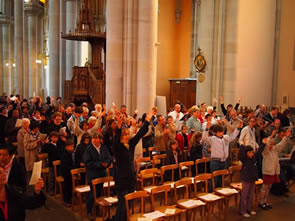 This was done in part through the introduction of new “praise and worship” songs to the Liturgy where the words focused more on a personal expression of love and adoration for God (eg. “Our God reigns”) than hymns that sang more so about God’s attributes. As it says in the Psalms,
This was done in part through the introduction of new “praise and worship” songs to the Liturgy where the words focused more on a personal expression of love and adoration for God (eg. “Our God reigns”) than hymns that sang more so about God’s attributes. As it says in the Psalms,
Sing to him a new song, play skillfully on the strings, with loud shouts… Sing praise to the LORD with the lyre, with the lyre and melodious song. (Psalm 33:3, 98:5)
Often, if not very often, it was the music that drew many souls into the Renewal and into a new conversion experience. I have written elsewhere about why praise and worship carries a spiritual power [3]see Praise to Freedom, but suffice it here to quote the Psalms again:
…you are holy, enthroned on the praises of Israel (Psalm 22:3, RSV)
The Lord becomes present in a special way when he is worshipped in His peoples praises—He is “enthroned” upon them. The Renewal, thus, became an instrument by which many people experienced the power of the Holy Spirit through praise.
The holy People of God shares also in Christ’s prophetic office: it spreads abroad a living witness to him, especially by a life of faith and love and by offering to God a sacrifice of praise, the fruit of lips praising His name. —Lumen Gentium, n. 12, Vatican II, November 21, 1964
…be filled with the Spirit, addressing one another in psalms and hymns and spiritual songs, singing and making melody to the Lord with all your heart. (Eph 5:18-19)
The Charismatic Renewal often inspired the lay to become more involved in the parish. Readers, servers, musicians, choirs, and other parish ministries were often boosted or started by those who, ignited by a new love for Jesus, wanted to devote themselves more to His service. I can remember in my youth hearing the Word of God proclaimed with a new authority and power by those in the Renewal, such that the Mass readings became much more alive.
It was also not uncommon in some Masses, mostly at conferences, to hear singing in tongues during the Consecration or after  Communion, what is called “singing in the Spirit,” another form of praise. Again, a practice not unheard of in the early Church where tongues were spoken “in the assembly.”
Communion, what is called “singing in the Spirit,” another form of praise. Again, a practice not unheard of in the early Church where tongues were spoken “in the assembly.”
What then, brethren? When you come together, each one has a hymn, a lesson, a revelation, a tongue, or an interpretation. Let all things be done for edification. (1 Cor 14:26)
In some parishes, the pastor would also permit extended periods of silence after Communion when a prophetic word could be spoken. This too was common, and encouraged, by St. Paul in the assembly of believers in the early Church.
Let two or three prophets speak, and let the others weigh what is said. (1 Cor 14:29)
OBJECTIONS
The Holy Mass, however, that has grown organically and evolved over the centuries belongs to the Church, not any one movement or priest. For that reason, the Church has “rubrics” or rules and prescribed texts that must be followed, not only to make the Mass universal (“catholic”), but also to protect its integrity.
…regulation of the sacred liturgy depends solely on the authority of the Church… Therefore, no other person, even if he be a priest, may add, remove or change anything in the liturgy on his own authority. —Constitution on the Sacred Liturgy, Art 22:1, 3
The Mass is the prayer of the Church, not an individual prayer or the prayer of a group, and thus, there should be a coherent unity among the faithful and a deep reverence for what it is, and has become over the centuries (excepting, of course, modern abuses which are serious and even a breech of the “organic” development of the Mass. See Pope Benedict’s book The Spirit of the Liturgy.)
So, my brothers, strive eagerly to prophesy, and do not forbid speaking in tongues, but everything must be done properly and in order. (1 Cor 14:39-40)
On Music…
In 2003, John Paul II publicly lamented the state of liturgical music in the Mass:
The Christian community must make an examination of conscience in order that the beauty of music and song increasingly return within liturgy. Worship must be purified of stylistic rough edges, of sloppy forms of expression, and of clumsy music and texts, which are hardly consonant with the greatness of the act being celebrated. —National Catholic Reporter; 3/14/2003, Vol. 39 Issue 19, p10
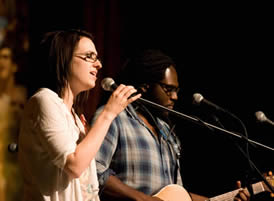 Many have wrongly condemned “guitars,” for example, as inappropriate for Mass (as if the organ were played in the upper room at Pentecost). What the Pope criticized, rather, was poor execution of music as well as inappropriate texts.
Many have wrongly condemned “guitars,” for example, as inappropriate for Mass (as if the organ were played in the upper room at Pentecost). What the Pope criticized, rather, was poor execution of music as well as inappropriate texts.
The pope noted that music and musical instruments have a long tradition as an “aid” to prayer. He cited Psalm 150’s description of praising God with trumpet blasts, lyre and harp, and clanging cymbals. “It is necessary to discover and constantly live the beauty of prayer and the liturgy,” the pope said. “It’s necessary to pray to God not only with theologically exact formulas but also in a beautiful and dignified way.” He said music and song could assist believers in prayer, which he described as the opening of a “channel of communication” between God and his creatures. —Ibid.
Thus, Mass music should be raised to the level of what is occurring, namely the Sacrifice of Calvary being made present in our midst. Praise and worship thus has a place, what Vatican II called “sacred popular music”, [4]cf. Musicam Sacram, March 5th, 1967; n. 4 but only if it attains…
…the true purpose of sacred music, “which is the glory of God and the sanctification of the faithful.” —Musicam Sacram, Vatican II, March 5th, 1967; n. 4
And so the Charismatic Renewal must also do an “examination of conscience” regarding its contribution to Sacred Music, weeding out music that is not appropriate for the Mass. There also has to be a re-evaluation of how music is played, by whom it is executed, and what are appropriate styles. [5]cf. Musicam Sacram, March 5th, 1967; n. 8, 61 One could say that “beauty” should be the standard. That is a broader discussion with varying opinions and tastes within cultures, which are more often than not losing the sense of “truth and beauty.” [6]cf. Pope challenges artists: make truth shine through beauty; Catholic World News John Paul II, for example, was very open to modern styles of music while his successor has been less attracted. Nonetheless, Vatican II clearly included the possibility of modern styles, but only if they are in keeping with the solemn nature of the Liturgy. The Mass is, by its very nature, a contemplative prayer. [7]cf. Catechism of the Catholic Church, 2711 And therefore, Gregorian chant, sacred polyphony, and choral music have always held a prized place. Chant, along with certain Latin texts, were never intended to have been “dropped” in the first place. [8]cf. Musicam Sacram, March 5th, 1967; n. 52 It is interesting that many youth are in fact being drawn back to the extraordinary form of the Liturgy of the Tridentine Mass in some places… [9] http://www.adoremus.org/1199-Kocik.html
On Reverence…
One has to be careful about judging the reverence of another soul as well as categorizing the entire Renewal according to one’s personal experiences. One reader responded to the criticisms of the above letter, saying:
How can we all be one when this poor person is so JUDGEMENTAL? What does it matter if you wear jeans to church— maybe that is the only clothing that person has? Didn’t Jesus say in Luke Chapter 2:37-41, that “you clean the outside, while inside yourselves, you are filled with filth“? Also, your reader is judging the way people PRAY. Again, Jesus said in Luke Chapter 2: 9-13 “How much more will the Heavenly Father, give THE HOLY SPIRIT to those who ask him.”
Yet, it is sad to see that genuflection before the Blessed Sacrament has disappeared in many places, indicative of the vacuum of proper instruction, if not interior faith. 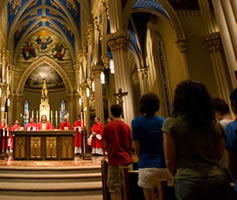 It is also true that some people dress no differently for a trip to the grocery store than they do to participate in the Lord’s Supper. Modesty in dress has also taken a hit, particularly in the Western world. But again, these are more so a fruit of the aforementioned liberalization, particularly in the Western Church, that has led to a laxity in many Catholics approach to the awesomeness of God. One of the gifts of the Spirit after all is piety. Perhaps of greatest concern is the fact that many Catholics have stopped coming to Mass at all within just the past few decades. [10]cf. The Decline and Fall of the Catholic Church There is a reason John Paul II called upon the Charismatic Renewal to continue “re-evangelizing” societies where “secularism and materialism have weakened many people’s ability to respond to the Spirit and to discern God’s loving call.” [11]POPE JOHN PAUL II, Address to the ICCRO Council, March 14, 1992
It is also true that some people dress no differently for a trip to the grocery store than they do to participate in the Lord’s Supper. Modesty in dress has also taken a hit, particularly in the Western world. But again, these are more so a fruit of the aforementioned liberalization, particularly in the Western Church, that has led to a laxity in many Catholics approach to the awesomeness of God. One of the gifts of the Spirit after all is piety. Perhaps of greatest concern is the fact that many Catholics have stopped coming to Mass at all within just the past few decades. [10]cf. The Decline and Fall of the Catholic Church There is a reason John Paul II called upon the Charismatic Renewal to continue “re-evangelizing” societies where “secularism and materialism have weakened many people’s ability to respond to the Spirit and to discern God’s loving call.” [11]POPE JOHN PAUL II, Address to the ICCRO Council, March 14, 1992
Is clapping or raising one’s hands irreverent? On this point, one has to note cultural differences. In Africa, for example, the prayer of the people is often expressive with swaying, clapping, and exuberant singing (their seminaries are bursting too). It is a reverent expression on their part for the Lord. Likewise, souls who have been set on fire by the Holy Spirit are not ashamed to express their love of God using their bodies. There are no rubrics in the Mass that expressly forbid the faithful from raising their hands (the “orantes” posture) during, for example, the Our Father, though it would not be considered the Church’s custom in many places. Some bishop’s conferences, such as in Italy, have been granted permission from the Holy See to expressly permit the orantes posture. As for clapping during a song, I believe the same holds true that there are no rules in this regard, unless the music chosen fails to “direct the attention of the mind and heart to the mystery which is being celebrated.” [12]Liturgiae Instaurationes, Vatican II, September 5th, 1970 The issue at heart is whether or not we are praying from the heart.
David’s prayer of praise brought him to leave all form of composure and to dance in front of the Lord with all his strength. This is the prayer of praise!… ‘But, Father, this is for those of Renewal in the Spirit (the Charismatic movement), not for all Christians.’ No, the prayer of praise is a Christian prayer for all of us! —POPE FRANCIS, Homily, January 28th, 2014; Zenit.org
Indeed, the Magisterium encourages harmony between body and mind:
The faithful fulfill their liturgical role by making that full, conscious and active participation which is demanded by the nature of the Liturgy itself and which is, by reason of baptism, the right and duty of the Christian people. This participation
(a) Should be above all internal, in the sense that by it the faithful join their mind to what they pronounce or hear, and cooperate with heavenly grace,
(b) Must be, on the other hand, external also, that is, such as to show the internal participation by gestures and bodily attitudes, by the acclamations, responses and singing. —Musicam Sacram, Vatican II, March 5th, 1967; n. 15
As for “women in the [sanctuary]”—female alter servers or acolytes—that again is not the produce of the Charismatic Renewal, but a relaxation in liturgical norms, right or wrong. The rules have at times been too relaxed, and extraordinary ministers have been used unnecessarily and given tasks, such as cleaning the sacred vessels, that should be performed by the priest alone.
WOUNDED BY THE RENEWAL
I have received several letters from individuals who were wounded by their experience in the Charismatic Renewal. Some wrote to say that, because they did not speak in tongues, they were accused of not being open to the Spirit. Others were made to feel as though they were not “saved” because they had not yet been “baptized in the Spirit,” or that they hadn’t yet “arrived.” Another man spoke about how a prayer leader was pushing him backward so that he would fall over “slain in the Spirit.” And yet others have been wounded by the hypocrisy of certain individuals.
Does it sound familiar?
Then an argument broke out among [the disciples] about which of them should be regarded as the greatest. (Luke 22:24)
It is unfortunate if not a tragedy that these experiences of some occurred. Speaking in tongues is a charism, but not given 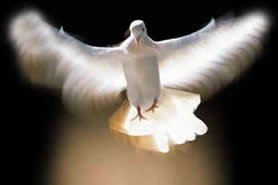 to all, and thus, not necessarily a sign that one is “baptized in the Spirit.” [13]cf. 1 Cor 14:5 Salvation comes as a gift to a soul through faith that is born and sealed in the Sacraments of Baptism and Confirmation. Thus, it is incorrect to say that a person who has not been “baptized in the Spirit” is not saved (though that soul may still need the release of these special graces so as to live more deeply and authentically a life in the Spirit.) In the laying on of hands, someone should never be forced or pushed. As St. Paul wrote, “Where the Spirit of the Lord is, there is freedom.” [14]2 Cor 3:17 And lastly, hypocrisy is something that plagues us all, for we often say one thing, and do another.
to all, and thus, not necessarily a sign that one is “baptized in the Spirit.” [13]cf. 1 Cor 14:5 Salvation comes as a gift to a soul through faith that is born and sealed in the Sacraments of Baptism and Confirmation. Thus, it is incorrect to say that a person who has not been “baptized in the Spirit” is not saved (though that soul may still need the release of these special graces so as to live more deeply and authentically a life in the Spirit.) In the laying on of hands, someone should never be forced or pushed. As St. Paul wrote, “Where the Spirit of the Lord is, there is freedom.” [14]2 Cor 3:17 And lastly, hypocrisy is something that plagues us all, for we often say one thing, and do another.
Conversely, those who have embraced the “pentecost” of the Charismatic Renewal have often been unfairly labeled and marginalized (“those crazy charismatics!“) not only by laymen but most painfully by clergy. Participants of the Renewal, and the charisms of the Holy Spirit, have at times been misundertood and even rejected. This has at times led to frustration and impatience with the “institutional” Church, and most notably, the exodus of some to more evangelical sects. Suffice it to say that there has been pain on both sides.
In his address to the Charismatic Renewal and other movements, John Paul II noted these difficulties that have come with their growth:
Their birth and spread has brought to the Church’s life an unexpected newness which is sometimes even disruptive. This has given rise to questions, uneasiness and tensions; at times it has led to presumptions and excesses on the one hand, and on the other, to numerous prejudices and reservations. It was a testing period for their fidelity, an important occasion for verifying the authenticity of their charisms.
Today a new stage is unfolding before you: that of ecclesial maturity. This does not mean that all problems have been solved. Rather, it is a challenge. A road to take. The Church expects from you the “mature” fruits of communion and commitment. —POPE JOHN PAUL II, Speech for the World Congress of Ecclesial Movements and New Communities, www.vatican.va
What is this “mature” fruit? More on that in Part IV, because it is the central key to our times.
Your donation at this time is greatly appreciated!
Click below to translate this page into a different language:
Footnotes
| ↑1 | Speech for the World Congress of Ecclesial Movements and New Communities, www.vatican.va |
|---|---|
| ↑2 | cf. Rom 8:28 |
| ↑3 | see Praise to Freedom |
| ↑4 | cf. Musicam Sacram, March 5th, 1967; n. 4 |
| ↑5 | cf. Musicam Sacram, March 5th, 1967; n. 8, 61 |
| ↑6 | cf. Pope challenges artists: make truth shine through beauty; Catholic World News |
| ↑7 | cf. Catechism of the Catholic Church, 2711 |
| ↑8 | cf. Musicam Sacram, March 5th, 1967; n. 52 |
| ↑9 | http://www.adoremus.org/1199-Kocik.html |
| ↑10 | cf. The Decline and Fall of the Catholic Church |
| ↑11 | POPE JOHN PAUL II, Address to the ICCRO Council, March 14, 1992 |
| ↑12 | Liturgiae Instaurationes, Vatican II, September 5th, 1970 |
| ↑13 | cf. 1 Cor 14:5 |
| ↑14 | 2 Cor 3:17 |


